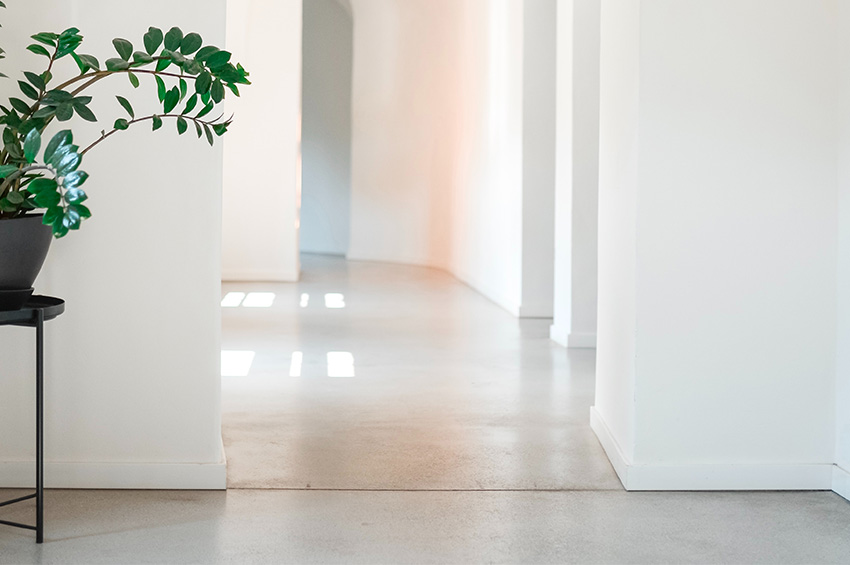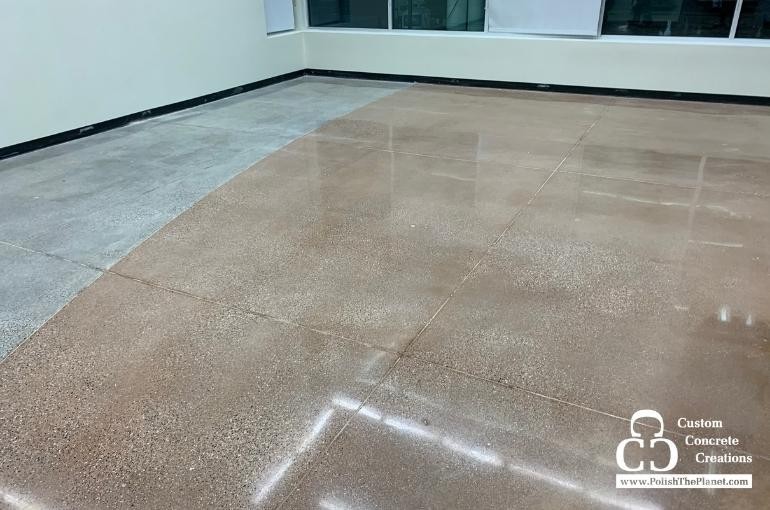Exploring the Providers Supplied for High-Quality Polished Concrete Flooring Solutions
Top quality polished concrete flooring remedies include a complex approach. Specialists start with a first appointment to analyze the details demands of the area. They after that use different surface preparation strategies to ensure perfect outcomes. Advanced grinding and brightening approaches follow, causing a polished coating. However, the process does not end there; choices for staining, securing, and continuous maintenance play crucial duties in the total result. What else should house owners take into consideration in this transformative flooring trip?
Preliminary Examination and Analysis
Just how can property owners ensure they receive the very best polished concrete flooring remedy? The response lies in the initial examination and evaluation procedure. Throughout this stage, homeowners engage with professionals to discuss their certain needs, choices, and budget plan. This discussion permits experts to evaluate the status quo of the area, recognizing any kind of prospective obstacles that might develop.
Experts frequently conduct an in-depth site browse through, keeping in mind of variables such as lights, web traffic patterns, and layout visual appeals. This analysis helps to establish one of the most suitable products and surfaces for the project. Property owners need to ask inquiries to understand the process much better and guarantee transparency relating to timelines and costs. Inevitably, a detailed initial consultation lays the structure for a successful polished concrete flooring task, straightening homeowner expectations with expert recommendations. This partnership is necessary for accomplishing an acceptable and enduring floor covering option.
Surface Area Prep Work Strategies
Prior to using polished concrete, reliable surface preparation strategies are important to assure a resilient and cosmetically pleasing surface. The preliminary step includes extensively cleansing the concrete surface area to eliminate any type of pollutants, such as oil, dust, and particles. This assures correct attachment of the polished coating. Adhering to cleansing, any kind of existing finishings or sealants need to be removed to reveal the raw concrete beneath. Moisture screening is likewise important, as excess moisture can result in bond failures. Furthermore, dealing with any type of cracks or surface flaws is necessary; this may include patching or filling up to develop a smooth, also canvas. Finally, the surface area needs to be reviewed for any kind of unevenness or damages, which can affect the total high quality of the polished coating. By adhering to these surface preparation strategies, specialists established the stage for effective sprucing up, inevitably boosting the longevity and appearance of the concrete floor covering.
Grinding and Leveling Procedures
The grinding and leveling procedures are vital actions in attaining a flawless polished concrete surface. These processes include using specialized machinery geared up with diamond-tipped blades that properly eliminate surface area imperfections and uneven areas. Originally, grinding concentrates on removing any type of existing finishings, adhesives, or contaminants, ensuring a tidy substratum for subsequent therapies.
Following this, leveling is conducted to deal with any kind of discrepancies in the concrete surface. This might involve the application of self-leveling compounds or extra grinding to achieve an uniform airplane. Proper leveling is essential, as it not just improves the visual charm yet additionally safeguards the durability of the polished concrete.
Brightening Approaches and Grading
Complying with the grinding and leveling processes, different brightening techniques are utilized to attain the preferred luster and surface area finish of concrete flooring. The most typical methods include completely dry brightening and wet polishing, each with distinct advantages. Dry brightening uses diamond-embedded pads and a vacuum cleaner system to lessen dust, making it ideal for interior environments. On the other hand, damp polishing entails making use of water to cool the pads and reduce friction, resulting discover here in a smoother coating.
Sprucing up normally follows a grading system, varying from rugged to fine. The grading range, frequently categorized from 50 to 3000 grit, identifies the level of shine attained. Lower grits (50-200) are used for first phases, while greater grits (800-3000) refine the surface area for a high-gloss finish. This methodical technique guarantees that each layer of gloss enhances the resilience and visual allure of the concrete flooring, providing to varied style preferences and functional demands.
Staining and Coloring Options

Kinds Of Concrete Stains
While concrete floor covering is naturally sturdy, the addition of color through discoloration can improve its aesthetic appeal and convenience. There are largely two sorts of concrete stains: acid-based and water-based. Acid-based stains respond chemically with the concrete, producing abundant, variegated colors that permeate deeply, creating a special, transparent coating. These discolorations often generate earthy tones like browns and terracottas yet might restrict color selections. On the other hand, water-based stains provide a more comprehensive range of vibrant shades and can be blended to attain custom tones. They remain on the surface area instead of pass through, permitting less complicated application and cleaning. Both kinds of spots provide enduring appeal, making them popular selections for improving polished concrete floor covering.

Personalized Shade Solutions
Custom-made shade remedies for polished concrete flooring allow home owners and organizations to individualize their areas with an one-of-a-kind aesthetic. Various discoloration and coloring choices are available, ranging from acid stains that produce rich, variegated tones to water-based stains that offer a more comprehensive combination with regular shade. Each approach improves the concrete's natural beauty while offering longevity. On top of that, essential shade, included throughout the blending process, warranties uniformity throughout the piece. These custom-made options make it possible for clients to match their floor covering with existing style or brand identifications. Furthermore, using sealers can additionally boost color vibrancy and secure versus wear. Overall, personalized color options are a reliable means to accomplish an unique and aesthetically attractive polished concrete surface.

Securing and Security Solutions
Securing and safeguarding polished concrete floor covering read review is important for keeping its visual allure and resilience with time. A top quality sealer works as a barrier versus stains, dampness, and put on, guaranteeing that the surface maintains its shine and integrity. Numerous sealing options are available, consisting of permeating sealants that take in into the concrete and topical sealers that form a safety layer externally. Each kind has one-of-a-kind advantages, such as enhancing shade and providing slip resistance.
Additionally, the option of sealant can depend upon the particular environment in which the flooring is set up, whether it's a domestic area or an industrial setting. Normal application of safety layers can expand the life-span of the flooring, making it a wise financial investment for residential or commercial property owners. Engaging specialists for sealing solutions warranties correct application techniques are made use of, taking full advantage of the safety high qualities of the sealant and attaining peak performance from the polished concrete flooring.
Maintenance and Aftercare Services
Correct maintenance and aftercare services are essential for maintaining the elegance and long life of polished concrete flooring. Regular cleansing is essential, as dirt and debris can boring the surface. Polished Concrete Austin Tx. Professionals suggest making use of a pH-balanced cleaner and a soft wipe to avoid damaging the surface. Furthermore, periodic reapplication of sealers can aid maintain the surface's shine and shield against discolorations
Routine assessments for cracks or chips need to likewise be performed to attend to any issues quickly, stopping additional damage. For high-traffic areas, applying a topical polish can improve the floor's look while supplying an additional layer of security.
Educating clients on the relevance of staying clear of rough chemicals and rough tools is critical for long-term maintenance. Generally, tailored upkeep and aftercare services are integral to guaranteeing that polished concrete floorings stay visually pleasing and functional for years to find.
Frequently Asked Questions
How Lengthy Does the Entire Polished Concrete Setup Process Take?
The duration of the polished concrete setup procedure usually varies from several days to a week. Factors such as area size, preparation work, and curing times can affect the total timeline considerably.
Can Polished Concrete Be Mounted Over Existing Flooring?
Polished concrete can be installed over existing floor covering, gave the underlying surface is structurally sound and appropriately prepared. This technique can conserve time and lower the requirement for considerable demolition during the renovation process.
What Are the Environmental Effects of Polished Concrete Flooring?
The environmental impacts of polished concrete flooring include minimized waste, lower why not find out more energy intake, and the potential for using recycled products. However, dust and emissions throughout installation might present temporary air top quality problems, calling for correct ventilation.
Is Polished Concrete Suitable for Outdoor Use?
Polished concrete can be suitable for exterior usage, supplied it is treated with ideal sealers to boost resilience and slip resistance. Its aesthetic appeal and reduced upkeep make it an eye-catching choice for outdoor areas.
What Is the Expense Range for Polished Concrete Floor Covering Solutions?
The cost range for polished concrete flooring services usually ranges $3 to $12 per square foot, influenced by variables such as the project's intricacy, the desired finish, and local market conditions.